The festival day actually started the evening before, with a huge storm. (Everyone agreed, obviously, that it was better to have had it Friday night than Saturday night.) It was inevitable; we’d spent the whole week under a hot, wet woollen blanket of weather, one of those classic mid-summer heat waves that makes you hold very still and concentrate on breathing.
At around 7 — actually, earlier — a large swath of gray-black clouds began to draw itself across the sky and the breeze picked up, but we knew the storm would (couldn’t, in fact) hit until the tide turned. So we were inside, around 8:00, when the first raindrops began. Big, heavy, aggressive raindrops, smashing into the pavement one by one. Then the rain really hit. And then it turned to hail. I love the hail, it hits the canal so hard the water looks like it’s boiling. The bits of ice blew and cracked and bounced against the Venetian blinds. And the air turned cool and we could breathe again.
Lino said, “Anybody who’s out on the water in a boat right now is a coglion (male anatomical part which is commonly referred to when needing to describe a person who is a dangerous mixture of stupidity and incompetence at a level which can create inconvenience or even danger to those around him.) This storm had been threatening since 4:00 and Lino has very little patience with people who can’t take care of themselves on the water due to ignorance of what, to him, are the most elementary elements of survival. Kind of like somebody who might sit down to read “War and Peace” who wasn’t too steady with the alphabet.
Saturday morning, the Big Day, 8:30 AM: I went to the cut-rate supermarket behind our place to get some last-minute supplies. I wasn’t the only person who had thought of getting a head start on the day; there were at least five people in line ahead of me.
As it happened, the late- middle-aged man in front and the attractive middle-aged woman behind me knew each other, so they were schmoozing over and around me, in a friendly sort of way.
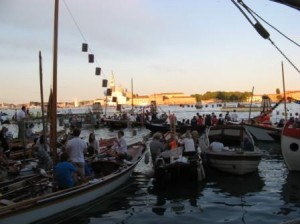
Man: “One year when we were boys we went and rented a boat to go out to watch the fireworks.” That was still the era when the late, lamented affittabattelli were in business. “There were about five or six of us. And we had bought fireworks, too, which we stashed under the prow of the boat.”
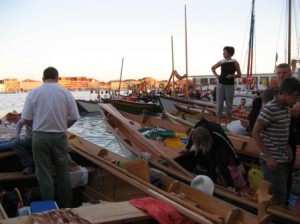
The boat was something like a sampierota, whose prow is covered; it makes a very useful storage place, which is precisely why it’s made that way. I guess you have to be a 12- or 13-year-old boy to understand the point of bringing fireworks to a fireworks display.
“Then we saw a man on the fondamenta in a tuxedo. He asked, ‘Hey, I’m late to get to the galleggiante — can you ferry me over?” “We said, Sure. So he got on and sat down on the prow.”
(“The galleggiante” literally means “floating thing,” and specifically referred to a large heavy platform which years ago on the night of the Redentor moved slowly around the Bacino of San Marco, festooned with lights, carrying a band playing music. They have attempted a version of it the past two years, but I think it may have lost its true beauty when everybody became capable of bringing their own music aboard their boats. Or maybe it cost too much. Remember: No ghe xe schei.)
The story continues: So the boys were rowing across from here to there and somehow all the fireworks under the prow ignited. Which means “exploded.” I never heard what set them off, but once they start, that’s it.
“The man in the tuxedo had to jump in the water and swim,” our guy continued. “In fact, we all did. It was like a powder magazine going up. The boat pretty much caught on fire and just kept burning.
“It took us two years to pay off that boat,” he concluded. “We’d go by and pay the boat-renter 5 franchi, 10 franchi, whatever we had.”
What did your parents say? I had to ask.
“Oh we never told our parents,” he answered.
This was a fantastic start to my day.
The rest of the festa went pretty much as anticipated:

Beauty. Merriment. Friends — some 14 of them, assorted. Food: the strictly traditional bigoli in salsa (whole-wheat spaghetti with anchovy sauce), sarde in saor (fried sardines in sweet-sour onion sauce), and bovoleti (tiny snails in oil and garlic). Some non-traditional meatballs, too. Lots of wine. And shortly before the fireworks began, we slaughtered the watermelon — there must be watermelon, it’s non-negotiable. The next morning you can still see shards of watermelon rind floating around.
The fireworks started 15 minutes late. This put a serious brake on the merriment, which is emotionally calibrated to the start of the uproar. At least I personally am so calibrated. Fifteen minutes is too long to keep your anticipation at its peak, especially if it’s practically midnight.
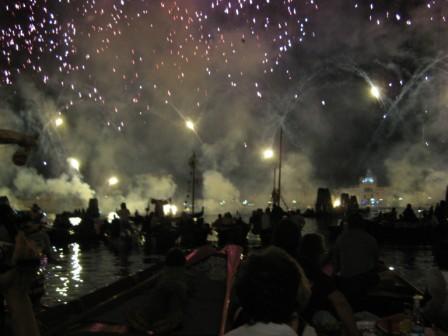
I will say that while there are no bad fireworks, there are those which are great and those which aren’t. These were not great. The Gazzettino reported the next day that they were “probably the best there had ever been,” which is preposterous. Last year they were the best that there had ever been, and ever will be. This year we had lag, and long pauses, and repetitions. I can say they were louder than usual, but I don’t give points for loud. The hailstorm the night before was much more exciting.
We rowed the caorlina back across the dark lagoon, as other homeward-bound boats chugged past us. Put the boat away, policed up the campground, so to speak (many bottles and other detritus to dispose of), and then home. Which on the Lido means waiting for the night bus, which is not frequent, and then the night vaporetto, ditto.
It was a fine Redentor, but I wouldn’t put it up in my top five, if anyone is keeping score. Apart from last year, the only other truly unforgettable one was the year we heard that a friend of ours had just “come off,” as climbers put it, a mountain in the Dolomites the afternoon of the Redentore. I’ll never forget sitting in our little mascareta that night, not eating, the fireworks all blurry, throat hurting. Poor Giorgio. I think of him every year.

But the next day happiness reigns once again, as the sun pours itself all over the city and down on the three afternoon regatas, and the stands in front of the church selling balloons and candies in alarming colors, and then the solemn mass and blessing of the city by the patriarch.
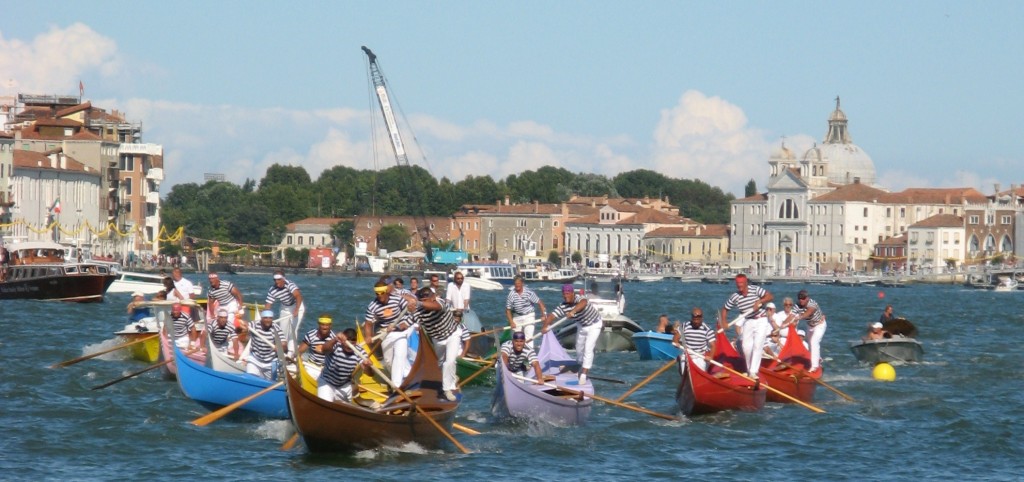
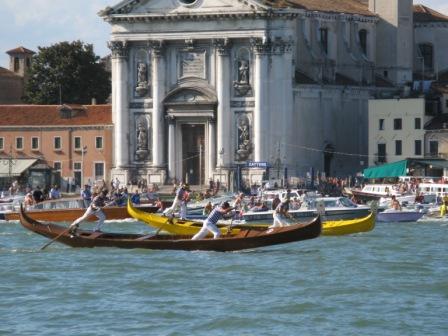
The patriarchal blessing is bestowed on the city from an ecclesiastical station assembled at the entrance to the church of the Redentore. The current patriarch, Angelo Cardinal Scola, seems to like the vantage point. But there are plenty who remember other patriarchs of Venice, who were also cardinals, then popes, then saints, who did it differently.
Both Pope John 23rd (“Papa Roncalli”) 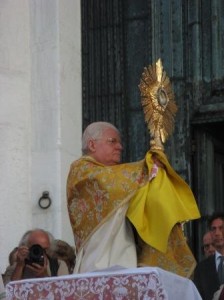


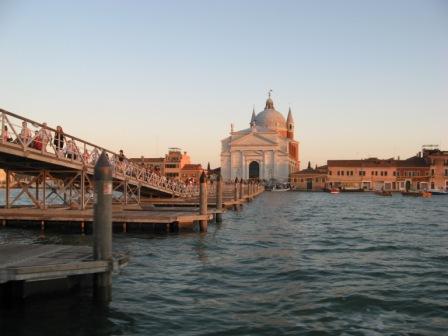
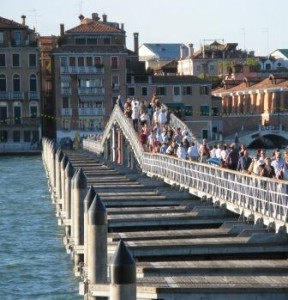
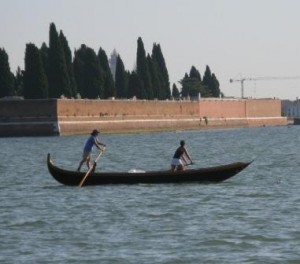 So he rented a batela a coa de gambaro (“shrimp-tail boat”), which is the second clue that we’re in the fairly distant past, because now there is only one, which I occasionally see being rowed around by two girls. Lino says it was made by the legendary late boatbuilder “Nino” Giupponi, who devised the framework by studying a painting, perhaps by Canaletto, who was great with boats. In any case, it’s not like the original ones. For one thing, it’s smaller, which you can well believe if the group in question numbered more than ten.
So he rented a batela a coa de gambaro (“shrimp-tail boat”), which is the second clue that we’re in the fairly distant past, because now there is only one, which I occasionally see being rowed around by two girls. Lino says it was made by the legendary late boatbuilder “Nino” Giupponi, who devised the framework by studying a painting, perhaps by Canaletto, who was great with boats. In any case, it’s not like the original ones. For one thing, it’s smaller, which you can well believe if the group in question numbered more than ten.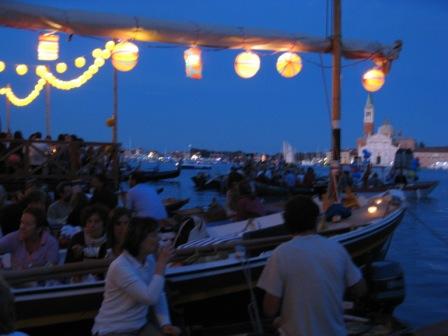
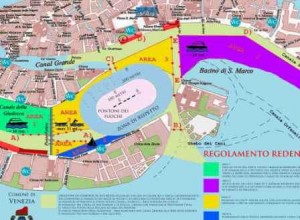
 You laugh and sing, if you’re in the mood, or if somebody near you starts it. You wave to your friends and call out remarks. This goes on for hours.
You laugh and sing, if you’re in the mood, or if somebody near you starts it. You wave to your friends and call out remarks. This goes on for hours.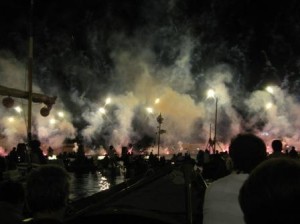 At the stroke of midnight the holy day begins, which means the party’s over, the bar’s closed, go home. Which we do. Carefully. Because when thousands of boats operated by people who have been eating and drinking for hours (or maybe not so much eating) start to move around in the dark, occasionally faster than they need to, it can be tricky.
At the stroke of midnight the holy day begins, which means the party’s over, the bar’s closed, go home. Which we do. Carefully. Because when thousands of boats operated by people who have been eating and drinking for hours (or maybe not so much eating) start to move around in the dark, occasionally faster than they need to, it can be tricky. 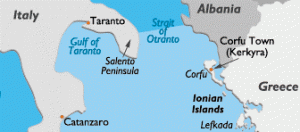 Our week in
Our week in 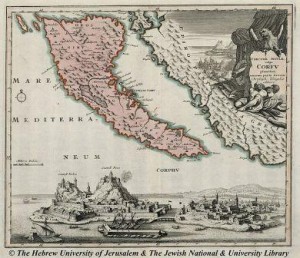
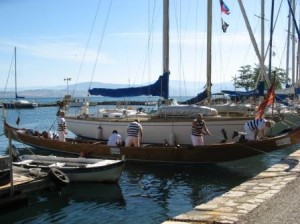
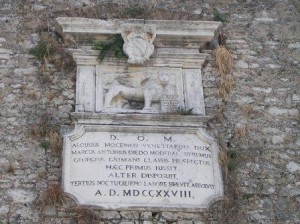
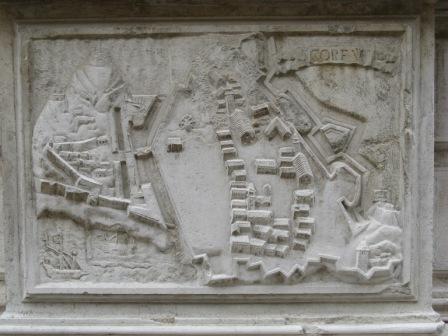
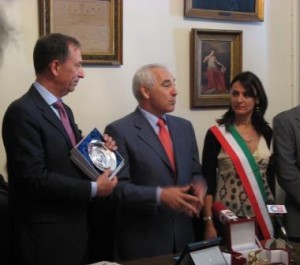


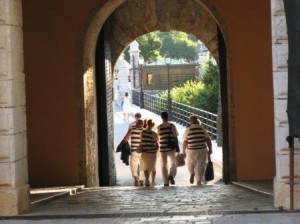
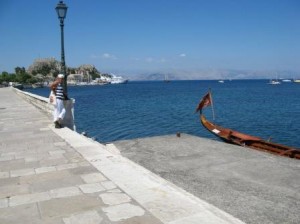
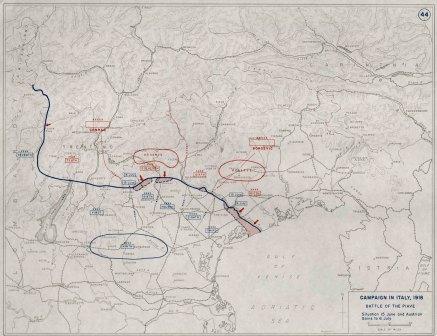 It is a pleasant little stream which starts in the Alps and empties into the sea not far from Venice, but more importantly, it formed the front which finally stopped the enemy advance and led to its ultimate defeat. The Piave is therefore also known as “The river sacred to the motherland.”
It is a pleasant little stream which starts in the Alps and empties into the sea not far from Venice, but more importantly, it formed the front which finally stopped the enemy advance and led to its ultimate defeat. The Piave is therefore also known as “The river sacred to the motherland.” 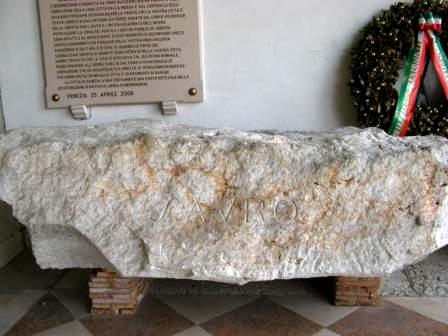 These are famous martyrs of the Italian resistance. Despite living in Austrian territory they considered themselves Italians were fighting for Italy, while according to the Austrian viewpoint they were supposed to be fighting against it. These men were epic heroes. I can’t understand why their life stories haven’t been turned into tragic operas. Where is Verdi when you need him?
These are famous martyrs of the Italian resistance. Despite living in Austrian territory they considered themselves Italians were fighting for Italy, while according to the Austrian viewpoint they were supposed to be fighting against it. These men were epic heroes. I can’t understand why their life stories haven’t been turned into tragic operas. Where is Verdi when you need him? 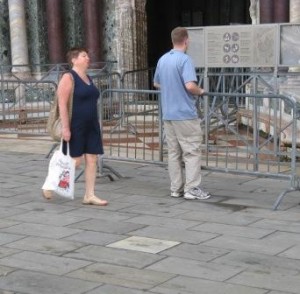
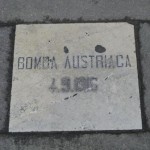
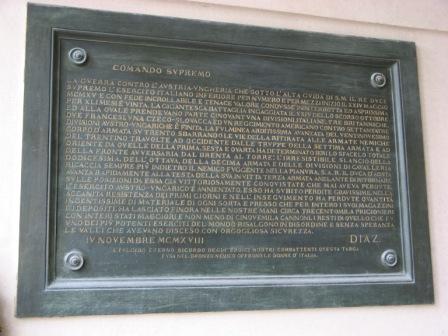 It gives the full text of the address given by General, later Marshal, Armando Diaz, chief of general staff, announcing the Italian victory of the Battle of Vittorio Veneto and the end of the war. It manages in very few lines not only to report the precise details of the enemy’s undoing but to convey every emotion conceivable in the victors of a struggle beyond human comprehension.
It gives the full text of the address given by General, later Marshal, Armando Diaz, chief of general staff, announcing the Italian victory of the Battle of Vittorio Veneto and the end of the war. It manages in very few lines not only to report the precise details of the enemy’s undoing but to convey every emotion conceivable in the victors of a struggle beyond human comprehension.